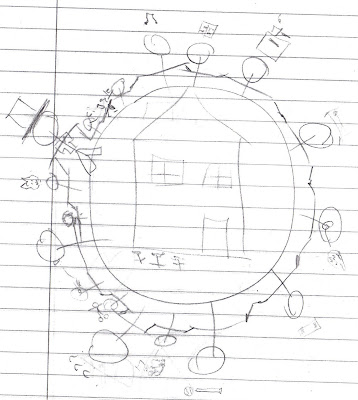The Andre House food line is famous among certain circles. If you haven't heard of it, you probably have never been homeless in downtown Phoenix. When we asked the youth a few months ago to help brainstorm activities for the retreat that would help the volunteers better understand the what it meant to be homeless, they had tons of suggestions. But one rose above the rest: "If you guys really want a taste, go through the Andre Food line."
At first I was hesitant. I was not at all interested in taking food out of the mouths of the hungry so that me and my little team could play at homelessness. But the youth insisted that the everyone would get fed and that us being there wouldn't be a problem. Just to be sure, I checked out the Andre House website, which makes it clear that all were welcome in the food line. So I put it on the schedule and made a donation to offset the cost of our meal.
Andre House was founded in 1984 by a pair of Catholic priests. What started as a simple invitation to a handful of people to stay the night has grown into many ministries. Andre House feeds 500 people daily and provides transitional housing for 11 people at a time, clothing to 150 weekly, laundry, showers, lockers, shoe vouchers, and blanket distribution. It also has daily Mass.
I felt it inappropriate to take pictures during our visit. While the members of our retreat agreed to be photographed and recorded, the people receiving Andre House's services did not. So you will have to rely on my memories.
We arrived at Andre House around 4:45 p.m. It is in the vicinity of the Central Arizona Shelter System and the other organizations that serve the homeless. The most striking element of the streets near these organizations is all the people in the actual street. There isn't a lot of through traffic, and most people are on foot. Perhaps there are more astute sociological explanations. Maybe there is a fearlessness associated with homelessness that makes cars the least of their worries. In a few cases, I think the liberal use of the streets is the result of substance use. Perhaps it is no more complex than sidewalks more often being used for sitting or sleeping.
When getting food at Andre, the first step is the line. We are given a one-square-inch piece of colored paper with a number printed on it. After the line, we sit on benches behind the building with shade structures overhead. The numbers ensure no seat swapping happens on the benches. While I understand the purpose of the benches and shade, namely that it is more comfortable than standing in the sun, I can't help but feel herded into a waiting stall.
We sit there for an hour. I think to myself that I could earn the cost of the free dinner in half the time it takes to wait for it.
Gabe is sitting next to me. He is my cultural interpreter. "The lady right there is going cold turkey." Maybe I'm hungry, but I think for a second he is talking about turkey, so I ask him to repeat. He gestures with his head, and notes her incessant scratching. "She's coming off something," he clarifies.
Gabe recounts story after story. He has seen people shoot up under the shade tent. He tells a handful of stories about the "fucking-psycho tourettes kid." Apparently he was let into CASS even though he was underage because his condition was so bad. One day in the Andre line, a large, intimidating man bumped into the psycho tourettes kid, and the tiny kid turned around and went insane on the huge man.
"Then we've got that," Gabe points, "people trying to sell their stuff." The Andre House line is also a place to buy rolled cigarettes and less legal paraphernalia. Currently it looks like someone is selling some kind of white packaged food item.
"Cops roll around here all the time looking for druggies and people sleeping on the streets. The sidewalk belongs to the church, and the other side belongs to CASS, so the only thing left to sleep on is the street."
After sitting for 45 minutes or more, the door to Andre House opens. The wheelchairs enter using the wheelchair ramp. A smiling woman collects the torn-off tickets in a red plastic coffee can. The first row starts to rustle. When the wheelchairs are all in, the first row goes up a set of stairs into the building.
Now it is our turn. We stand and process up. All the volunteers are smiling. It is pretty noisy in the building. I am served goulash. It is possible it is
goat goulash. I am also given a salad, mixed fruit salad, and a small drinkable yogurt. The cafeteria tables are full of people already eating. A large portrait of St. Andre looks over us as we dine.
We take a moment of gratitude and dig in. Very soon bargains are being made. I get 3/4 of someone's goulash in exchange for my yogurt. I want the starchy carbs. A few people don't finish parts of their meal. Michael and I attend to the scraps.
On the way out, a young woman gives me a brown paper bag with a peanut butter and grape jelly sandwich in it. It feels good to get handed food when full, as it give me comfort for the future. I do, however, immediately worry for the people with peanut allergies.







